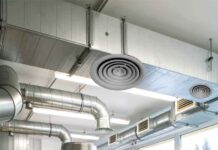
India stands at a pivotal moment in its developmental journey, balancing rapid urbanization with the urgent need for sustainability. With the construction sector contributing approximately 8.1% to India’s GDP in 2010-11 and projected to grow significantly by 2030, the environmental footprint of buildings has become a critical concern.
Buildings account for over 33% of India’s electricity consumption and approximately 17% of the nation’s Greenhouse Gas (GHG) emissions. As the country aims to reduce its emissions intensity by 45% by 2030 and achieve net-zero by 2070, green buildings have emerged as a cornerstone of sustainable development. Central to this transformation are high-efficiency Air Handling Units (AHUs), which play a pivotal role in optimizing energy use, improving indoor air quality, and reducing the environmental impact of buildings.
The Rise of Green Buildings in India
Green buildings are designed to minimize environmental impact through resource-efficient processes across their lifecycle – from planning and construction to operation and deconstruction. In India, the concept has gained traction due to escalating energy demands, resource scarcity, and climate change concerns. The India Cooling Action Plan (ICAP) projects an eightfold increase in cooling demand by 2037, driven by rising temperatures and widespread air conditioner ownership, which could increase peak electricity demand sixfold by 2050. Green buildings, which can reduce energy consumption by 20–30%, CO2 emissions by up to 35%, and water use by 11%, offer a viable solution to mitigate these challenges.
Key to achieving these efficiencies are advanced building systems, particularly in Heating, Ventilation, and Air Conditioning (HVAC), which account for 45–65% of a building’s electricity consumption. High-efficiency AHUs, as critical components of HVAC systems, are transforming how buildings manage air circulation, temperature, and quality while aligning with India’s sustainability goals.
Understanding high-efficiency air handling units
Air Handling Units (AHUs) are sophisticated systems that condition and circulate air within buildings. Typically housed in large metal enclosures, AHUs connect to ductwork to distribute conditioned air and return it for reprocessing.
A standard AHU comprises ventilators, fans, filters, heating or cooling coils, and dampers, all working together to regulate temperature, humidity, and air quality. High-efficiency AHUs, however, incorporate advanced technologies to optimise performance and minimize energy consumption.
Key features of high-efficiency AHUs include
- Variable Air Volume (VAV) Systems: These systems adjust the volume of air delivered based on real-time thermal and system loads, reducing fan energy consumption. By using frequency inverters to vary fan speed, VAV systems ensure precise control, unlike traditional constant-volume systems.

- High-Efficiency Fans: Modern AHUs employ airfoil or backward-curved fans, which offer superior aerodynamic performance, reducing energy losses compared to older forward-curved designs.

- Advanced Filtration: Electrostatic or High-Efficiency Particulate Air (HEPA) filters improve indoor air quality by removing pollutants, while low-pressure-drop designs minimize energy required for air movement.

- Heat Recovery Systems: Energy Recovery Ventilators (ERVs) or heat recovery wheels capture waste heat or coolness from exhaust air, pre-conditioning incoming air to reduce the load on heating or cooling coils.

- Low-Leakage Casings: Aluminium or insulated casings prevent air leakage, enhancing system efficiency and durability compared to traditional steel units that may rust or corrode.
- Smart Controls and IoT Integration: Internet of Things (IoT)-enabled AHUs use sensors and data analytics to optimize performance, monitor energy use, and predict maintenance needs, ensuring consistent efficiency.
These features make high-efficiency AHUs a cornerstone of sustainable building design, particularly in India’s tropical climate, where cooling demands dominate energy consumption.
The Role of High-Efficiency AHUs in Green Buildings
High-efficiency AHUs contribute to green buildings in several critical ways, aligning with certification systems like Leadership in Energy and Environmental Design (LEED) and Green Rating for Integrated Habitat Assessment (GRIHA), which are widely adopted in India.


Energy efficiency and reduced carbon footprint
HVAC systems are the largest energy consumers in commercial buildings. High-efficiency AHUs reduce energy use through VAV systems, high-efficiency motors, and heat recovery technologies. For example, the CII-Sohrabji Godrej Green Business Centre in Hyderabad, the world’s first LEED Platinum-rated building outside the U.S., employs energy-efficient HVAC systems to achieve 70% less energy consumption than conventional buildings. Similarly, Suzlon One Earth in Pune uses advanced AHUs alongside renewable energy sources to achieve net-zero energy status. By reducing energy demand, these units help lower GHG emissions, supporting India’s climate goals.
Improved Indoor Air Quality (IAQ)
Green buildings prioritize occupant health, and high-efficiency AHUs enhance IAQ through advanced filtration and ventilation. Electrostatic filters and HEPA systems remove dust, allergens, and pollutants, creating healthier indoor environments. The ITC Green Centre in Gurgaon, a LEED Platinum-certified building, integrates high-efficiency AHUs to ensure superior air quality while maintaining energy efficiency.
Water conservation
Some AHUs incorporate evaporative cooling or condensate recovery systems, reducing water use in HVAC operations. This aligns with green building goals of minimizing water consumption, as seen in projects like the Indira Paryavaran Bhawan in New Delhi, which combines AHUs with water-efficient systems to achieve net-zero criteria.
Cost savings and economic benefits
While high-efficiency AHUs may have higher upfront costs, they yield significant long-term savings through reduced energy and maintenance expenses. A 2023 report indicates that green buildings in India achieve average operating cost savings of 10.5% in their first year. For instance, Air Enterprises’ aluminum AHUs, designed for longevity, lower replacement costs and maintenance needs, enhancing the economic viability of green buildings.
Compliance with building codes
India’s Energy Conservation Building Code (ECBC) and the updated Energy Conservation and Sustainability Building Code (2022) emphasise energy-efficient HVAC systems. High-efficiency AHUs help buildings comply with these standards, earning certifications like ECBC or Super ECBC. The Eco-Niwas Samhita, a residential building energy code, further underscores the importance of efficient HVAC systems in achieving sustainable construction.
Case Studies: High-Efficiency AHUs in Action
Several iconic green buildings in India demonstrate the transformative impact of high-efficiency AHUs.
- CII-Sohrabji Godrej Green Business Centre, Hyderabad: As the first LEED Platinum-rated building globally outside the U.S., this structure uses energy-efficient AHUs with VAV systems and heat recovery to achieve 70% energy savings. Its design integrates natural ventilation and advanced filtration, setting a benchmark for sustainable corporate architecture.
- Suzlon One Earth, Pune: This LEED Platinum and GRIHA Five-Star-rated campus employs high-efficiency AHUs alongside wind turbines and solar panels to meet 100% of its energy needs sustainably. The AHUs optimise daylight exposure and air circulation, reducing reliance on artificial cooling.
- Infosys, Mysore: With a LEED Platinum rating, this building uses high-efficiency AHUs to achieve a 40% reduction in energy consumption. Its HVAC systems incorporate smart controls and heat recovery, demonstrating scalable solutions for large-scale offices.
- Rajiv Gandhi International Airport, Hyderabad: As Asia’s first LEED Silver-rated airport, it integrates high-efficiency AHUs to save 3.97 million kWh annually, reducing its carbon footprint by 3,331 tons. The AHUs support the airport’s extensive green belt and energy-efficient design.
These projects highlight how high-efficiency AHUs enable buildings to achieve top-tier sustainability certifications while delivering operational and environmental benefits.
Challenges and Opportunities
Despite their benefits, the adoption of high-efficiency AHUs in India faces challenges:
- High Initial Costs: Advanced AHUs require significant upfront investment, which can deter developers in a cost-sensitive market. However, financial incentives like tax breaks and subsidies, as outlined in a 2023 study, can offset these costs.
- Lack of Awareness and Skills: Policymakers, architects, and engineers often lack adequate knowledge of sustainable HVAC technologies. Training programs and awareness campaigns, such as those by the Bureau of Energy Efficiency, are critical to bridging this gap.
- Implementation Gaps: While policies like the ECBC exist, enforcement remains weak. Strengthening regulatory frameworks and integrating AHU standards into building codes can drive adoption.
- Opportunities abound: The green building sector is projected to create numerous jobs, from manufacturing AHUs to installing and maintaining them. Companies; like Brightflow, a leading Air Handling Unit manufacturer in India; are pioneering that meet global standards, fostering innovation and economic growth. Additionally, IoT-driven AHUs, as offered by startups like 75F, enable real-time energy optimisation, aligning with India’s push for smart cities.
The Path Forward
To fully harness the potential of high-efficiency AHUs in engineering a sustainable India, stakeholders must collaborate across sectors:
- Policy Support: Strengthening enforcement of the ECBC and Eco-Niwas Samhita, alongside financial incentives like property tax exemptions, can accelerate AHU adoption.
- Industry Innovation: Manufacturers should focus on cost-effective, scalable AHU solutions tailored to India’s diverse climates. Partnerships with global leaders can enhance technology transfer.
- Education and Training: Universities and institutions like Sri Ramakrishna Engineering College, with its Green Technology specialisation, can train engineers in sustainable HVAC design, ensuring a skilled workforce.
- Public-Private Partnerships: Initiatives like the EESL-GAIL MoU for trigeneration projects demonstrate how collaborative models can scale sustainable technologies, including AHUs.

Aman Taluja is a dedicated professional in the HVAC industry, currently involved in operations at Brightflow Engineers Pvt. Ltd. Based in Kundli, Haryana, the company specializes in manufacturing Air Handling Units, Evaporative Cooling Units, Dry Scrubbers, and Fan Coil Units. With a proven track record, Aman has successfully contributed to various prestigious projects, including installations at NTPC Dadri, Deloitte Gurugram, Le Meridien Hyderabad, Marriott Amritsar, and GAIL, Dibiyapur. His expertise in delivering high-quality air management solutions underscores his commitment to enhancing indoor air quality and operational efficiency.








